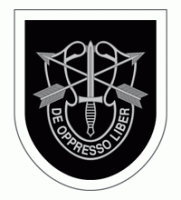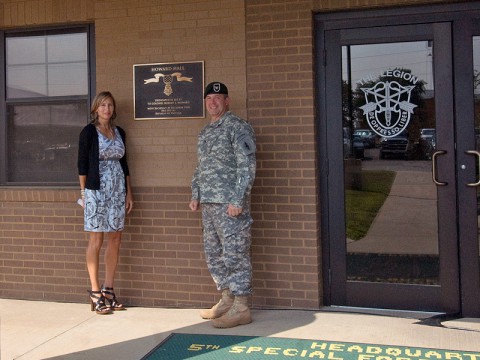Written by Maj. Brandon Bissell
5th Special Forces Group (Airborne) Public Affairs
 Fort Campbell, KY – Bob Howard grew up in Opelika, Alabama, in a house on a hill accessed by a single road. At the bottom of the hill living in two houses on either side of the road were two families, each with several boys that were both older and bigger than him.
Fort Campbell, KY – Bob Howard grew up in Opelika, Alabama, in a house on a hill accessed by a single road. At the bottom of the hill living in two houses on either side of the road were two families, each with several boys that were both older and bigger than him.
Bob Howard was a smart boy. He knew the odds were not in his favor if he challenged the boys, so every day on his way home from school he would devise a different plan to get past the boys and up the hill to his home without getting into trouble.

Reaching the front of his house, he was met by his grandmother, a tough-as-nails, no-nonsense woman, who asked him, “What are you running from? What in the world are you doing?”
He explained to his grandmother about the boys and why he was running. His grandmother looked him dead in the eyes and said, “Boy, don’t you ever run from anything again. Next time you walk up that hill and look those boys straight in the eyes.”
The next day Bob was walking home. As he arrived at the two houses at the bottom of the hill, he took a deep breath and remembered what his grandmother told him. Holding his head high, he walked between the two houses until he came face-to-face with the crowd of boys.
To this day no one knows exactly what happened between the bottom and the top of that hill, but according to Bob when he arrived at his house he was beaten a bit and his clothes were torn, but he had a smirk on his face and his shoes on his feet.
That is a perfect illustration of the way retired Army Col. Robert L. Howard lived his life and it was a fitting story shared with those in attendance at the dedication ceremony of the 5th Special Forces Group (Airborne) headquarters building named in his honor July 3rd by his daughter Mrs. Melissa Gentsch.
Howard served his country for more than 50 years, spending 36 years on active duty in the U.S. Army and the remainder working for the Department of Veteran’s Affairs. During his career he participated in two movies, The Longest Day and The Green Berets, both featuring John Wayne. He died in 2009 from pancreatic cancer.
Howard is the most decorated Soldier to have served in the Vietnam War. He was nominated for the Medal of Honor on three separate occasions for three separate acts over the span of 13 months; ultimately receiving the award at the White House from President Richard M. Nixon in 1971 for his actions corresponding to the third nomination.
In addition to the Medal of Honor, Howard was awarded the Distinguished Service Cross, the Nation’s second highest award for valor, the Silver Star, the third highest award, and numerous lesser valorous decorations including eight Purple Hearts in recognition of the 14 times he was wounded over the span of 55 months he served in combat.
In December 1968, Col. Howard (then a Sergeant 1st Class), was a Special Forces Platoon Sergeant for an American-Vietnamese platoon when his acts of gallantry merited the Medal of Honor. Howard was part of a mission to rescue a missing American Soldier in enemy controlled territory in Cambodia.
After leaving its helicopter landing zone, the platoon was attacked by an enemy element estimated to be the size of two companies. Howard, along with his platoon leader, was wounded during the initial engagement. He was weaponless and unable to walk.
Without hesitating Howard dragged the wounded officer to the platoon area and immediately rallied the platoon into an organized defense force. With complete disregard for his own safety, Howard crawled from position to position, administering first aid and directing fire on the encircling enemy.
For three and a half hours, what was left of Howard’s small force fought off a determined enemy attack, ultimately allowing helicopters to land and rescue the remainder of the force. That day only six of the 37 members of his platoon survived the battle. If not for Colonel Howard, there most likely would have been no survivors.
“[Howard] was not seeking glory. He was not seeking recognition. He was doing what needed to be done,” stated Brower. “He faced a determined enemy. He faced his own fears. He ran to the aid of others at the risk of his own life. He did what needed to be done.”
At the end of the day Howard was doing what his grandmother told him to do that afternoon at the top of the hill in Opelika, Alabama, “Boy, don’t you ever run from anything again. Next time you walk up that hill and look those boys straight in the eyes.”
Those are easy words to say, but not easy to act on. It says a tremendous amount about Howard’s character and courage.
Brower closed his remarks by reflecting on the importance of honoring Howard and his family on this day.
To the Soldiers in the formation Brower remarked, “We now have the opportunity to repay him for all that he has done for us. While we recognize him by placing his name and likeness on the building, we repay him by how we conduct ourselves each and every day. We honor him by striving to live up to the example that he set for us over the course of his career. While we are associated with this Group, we are associated with Colonel Howard. We will not take that responsibility lightly.”
Reflecting on what this memorialization would mean to her father, Mrs. Gentsch closed by adding, “I know what my father would want me to say today. He would ask that when you walk by this building do not think of him, but of what he embodied – a true Soldier, a Soldier who always put God and his country above all else.”
The dedication plaque, which hangs immediately outside the entrance to Howard Hall, serves as a constant reminder to all Green Berets who pass through its doors of what duty, service, and sacrifice truly mean.


